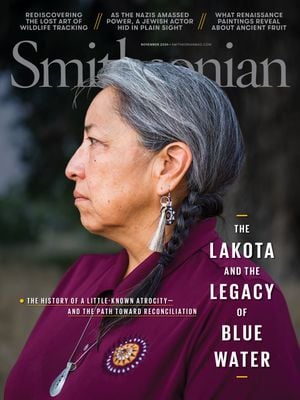OFFICE OF THE SECRETARY OF THE SMITHSONIAN
The Global Story of Slavery in the Americas Comes to the Smithsonian
“In Slavery’s Wake,” an international exhibition set to debut next month, illuminates the unfinished work of securing freedom
:focal(503x402:504x403)/https://tf-cmsv2-smithsonianmag-media.s3.amazonaws.com/filer_public/cd/82/cd82b89b-f810-465f-9c0b-e6d36dcefceb/nov2024_e01_secretarycolumn.jpg)
I grasped the enormity of this history when I visited Valongo Wharf, Rio de Janeiro’s largest disembarkation point for Africans transported to the Americas. The violent history there stands in contrast to the human stories of resistance and resilience I saw reflected in artifacts retrieved from the Valongo archaeological site, including shells, beads and pipes Africans had brought with them.
This complex history was poignantly underscored about 105 miles west of Rio. There, at the point where the mouth of the Bracuí River meets the sea, lie the remains of the Camargo, one of the last documented vessels to have transported enslaved Africans to Brazil. The site was discovered in 2023 through the efforts of Brazilian partners with the Slave Wrecks Project, an international collaboration hosted by the National Museum of African American History and Culture (NMAAHC).
During the trip, Elizabeth Bagley, the U.S. ambassador to Brazil, and I announced the launch of “Afro-Connections,” an exchange program working with Brazilian organizations to promote museum work that illustrates the struggles for freedom of people of African descent.
This collaborative work will take root in the upcoming exhibition “In Slavery’s Wake: Making Black Freedom in the World,” a NMAAHC-led project, which will embody that same spirit of resilience, resistance and healing. Opening December 13 at NMAAHC, the first of six museums on four continents it will visit (the second stop is in Brazil), this project includes several Valongo artifacts, interactive media, art and newly filmed oral histories detailing how the legacy of slavery and colonialism shapes our world. “In Slavery’s Wake” will demonstrate our shared connections to this history and illuminate how the unfinished work of freedom is essential to our future.
Weighted with history yet full of hope, my visit to Brazil was enlightening, inspiring and joyful. While most of what I received was intangible, I was given a small container of the soil members of the descendant communities had brought from their homes to pour over the wreck site of the Camargo. This item will join NMAAHC’s collection as a potent symbol of the full history of the trans-Atlantic slave trade and the healing power of remembering and reckoning with that history.

